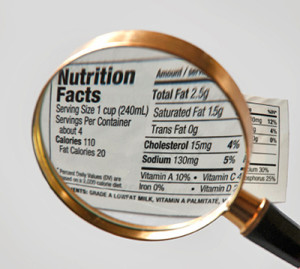Food labels: What means healthy and what doesn’t?
My kids hate grocery shopping with me. Why? Because I can’t just walk through the isles and pick up a bottle of mayonnaise or a box of cereal and be on my merry way. I have to thoroughly read the labels and ingredients before picking. I like to think I’m being a good example to them and preparing the next generation be be healthier, but at this stage, they just know the only thing standing between them and getting home to watch Lego Batman (their choice of entertainment while I put away groceries and make lunch) is that label. Because I read so many labels, product packaging has become a huge pet peeve for me. Just because something claims to be a healthy food, comes in a green box or has a leaf on the jar, doesn’t make it healthy. In fact, there have been several times I’ve put back a proclaimed “healthy” item for an item in plain packaging, making no claim to health. The idea is, it’s important to know what labels mean.
- Organic – What does it mean? According to Organic.org, organic food is produced without “pesticides, synthetic fertilizers, sewage sludge, genetically modified organisms, or ionizing radiation.” This doesn’t necessarily mean healthy. Last year, I noticed my son would get emotional and anxious if he ate too much sugar. We immediately started a quest to lower his sugar intake. One thing we changed was his morning yogurt. I found a vanilla yogurt with 6 grams of sugar a serving. A few weeks later they were out of the kind we buy, so I looked for other options for the week. I found an organic version of the same yogurt. The yogurt with 6 grams of sugar and the organic version were the same brand, same flavor and same serving size. There was only one difference. The organic version of the same yogurt had 12 grams of sugar per serving. The moral of this fascinating story is, organic is good, but it doesn’t always mean healthy. Unhealthy ingredients come in an organic version as well.
- Gluten Free – What does it mean? According to Gluten Free Dietitian, gluten-free foods don’t include, “grains wheat, barley, rye, or hybrids of these grains.” This summer we took a trip to Estes Park, Co. While walking along the boardwalk, we saw a small candy shop with a taffy pull in the window. The window had a huge sign that said “Gluten-Free Taffy!!” Since taffy is made of corn syrup, sugar, artificial coloring and artificial flavoring, making it without gluten doesn’t exactly make it a health food. I personally don’t eat a lot of gluten because it makes me break out like a hormonal teenager, but there are plenty of unhealthy foods out there that don’t contain gluten.
- Low-Fat – What does it mean? According to the Calorie Control Council, low fat means the food has “3 grams or less of total fat” per serving. The problem is, they generally replace the fat with sugar. Next time you’re in a grocery store, pick up a low-fat and a full-fat version of the same item. For the most part, you’ll find the low-fat version has more sugar. We’ve demonized fat for far too long. While I’m not suggesting eating Crisco for breakfast, your body needs healthy fats to survive. My mom remembers when the world came out with the idea of low fat. She was watching TV one day and the newscaster claimed you could eat candy, cakes, cookies and other treats as long as they were low-fat. And that was when our country fell into the obesity epidemic we’re now in. The problem is, this lulls us into a false sense of security. We interpret “low-fat” as “won’t make you fat.”Eating an entire carton of low-fat ice cream isn’t going to help your waist-line. Sugar will make you “fat” much faster than fats found in foods; especially healthy fats like nuts, avocado and coconut.
- All-Natural – What does it mean? The USDA defines all-natural as food that “does not contain artificial ingredients or preservatives and the ingredients are only minimally processed. However, they may contain antibiotics, growth hormones, and other similar chemicals.” It’s great there are no growth hormones or artificial ingredients, but that doesn’t mean healthy. As we’ve already mentioned, unhealthy ingredients can come in natural forms, but all-natural may still contain some chemicals.
- Sugar-Free – What does it mean? According to the FDA, a food is sugar-free if it contains “less than 0.5 grams of sugar per serving and contains no ingredient that is a sugar or generally understood to contain sugars.” This is one of the worst labels to me. When I see the label “sugar-free,” my mind sees it as “Will bloat you and give you more gas than an old man at a bean eating contest.” Sugar-free generally means it contains artificial sweeteners which are just as bad if not worse than sugar. Not only do they fuel sugar addictions, but they can affect your hormones and digestive systems in a bad way. Unless it’s naturally sugar-free, stay away from anything that claims to be sugar free.
The purpose of this post isn’t to make you turn away from organic, natural ingredients. I buy organic, natural, low sugar food whenever possible. The point is: read up on ingredients and nutrition facts. If it’s full of ingredients you’ve never heard of and can’t pronounce, stay clear of it. Even if it’s all-natural, organic and gluten free; if it has 35 grams of sugar per serving, it’s probably not something you want around. Don’t become a basket case about it (pot calling the kettle black???) but know what you’re putting in your body and why.

